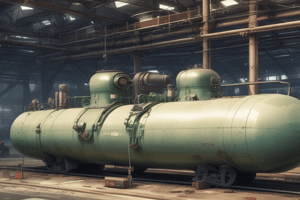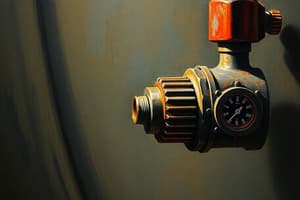Podcast
Questions and Answers
What is pneumatics primarily concerned with?
What is pneumatics primarily concerned with?
- The operation of systems using solid materials
- The transmission of power through electrical currents
- The operation of systems using air or gaseous medium (correct)
- The storage of energy in liquid form
What is the composition of dry air at sea level in terms of nitrogen percentage?
What is the composition of dry air at sea level in terms of nitrogen percentage?
- 1.013%
- 78.03% (correct)
- 20.99%
- 0.98%
What does the equation P = F/A represent in pneumatics?
What does the equation P = F/A represent in pneumatics?
- The relationship between pressure, volume, and temperature
- The relationship between speed and distance
- The relationship between pressure, force, and area (correct)
- The relationship between energy and mass
Which of the following is NOT a component typically found in a simple pneumatic system?
Which of the following is NOT a component typically found in a simple pneumatic system?
What is the SI unit of pressure as used in pneumatic systems?
What is the SI unit of pressure as used in pneumatic systems?
Which of the following gases is NOT a major component of atmospheric air?
Which of the following gases is NOT a major component of atmospheric air?
What causes atmospheric pressure as indicated in the content?
What causes atmospheric pressure as indicated in the content?
Which of the following statements regarding pneumatic power is true?
Which of the following statements regarding pneumatic power is true?
What is the role of the intake filter in a pneumatic system?
What is the role of the intake filter in a pneumatic system?
Which ISO standard pertains to the graphic symbols and circuit diagrams used in fluid power systems?
Which ISO standard pertains to the graphic symbols and circuit diagrams used in fluid power systems?
What is the primary function of an air compressor in a pneumatic system?
What is the primary function of an air compressor in a pneumatic system?
Which component is responsible for removing moisture from compressed air in a pneumatic system?
Which component is responsible for removing moisture from compressed air in a pneumatic system?
What is indicated by the term 'CETOP RP41' in pneumatic standards?
What is indicated by the term 'CETOP RP41' in pneumatic standards?
What purpose does a pressure regulator serve in a pneumatic system?
What purpose does a pressure regulator serve in a pneumatic system?
Which of the following is NOT a component typically involved in the generation of compressed air?
Which of the following is NOT a component typically involved in the generation of compressed air?
What does the VDMA stand for in the context of engineering associations?
What does the VDMA stand for in the context of engineering associations?
Which method of actuation is NOT commonly used for valves?
Which method of actuation is NOT commonly used for valves?
What does the first square from the left in a control valve symbol typically represent?
What does the first square from the left in a control valve symbol typically represent?
How are the inlet and outlet ports represented in a control valve symbol?
How are the inlet and outlet ports represented in a control valve symbol?
Which of the following is NOT a type of functional valve classification?
Which of the following is NOT a type of functional valve classification?
What is indicated by the line drawn at a right angle to the horizontal line inside the rectangle of a control valve symbol?
What is indicated by the line drawn at a right angle to the horizontal line inside the rectangle of a control valve symbol?
How many positions does a three-position valve typically have?
How many positions does a three-position valve typically have?
Which of the following describes a direction control valve (DCV)?
Which of the following describes a direction control valve (DCV)?
What does the number or letter labeling on the outside of a box in a valve symbol indicate?
What does the number or letter labeling on the outside of a box in a valve symbol indicate?
What does the pore size of a compressed air filter indicate?
What does the pore size of a compressed air filter indicate?
Why is dry compressed air generally preferred?
Why is dry compressed air generally preferred?
Which components of the compressed air system may require lubrication?
Which components of the compressed air system may require lubrication?
What functions does a service unit typically combine?
What functions does a service unit typically combine?
Where are service units usually installed in a compressed air system?
Where are service units usually installed in a compressed air system?
What characterizes a 5/2 way valve when activated?
What characterizes a 5/2 way valve when activated?
Which type of 3/2 way valve is operated using a push button?
Which type of 3/2 way valve is operated using a push button?
Which statement is true regarding the internal construction of a 3/2 way normally closed valve?
Which statement is true regarding the internal construction of a 3/2 way normally closed valve?
What is a characteristic of a roller operated 3/2 way valve?
What is a characteristic of a roller operated 3/2 way valve?
How does a pneumatically operated spring returned 5/2 way valve function?
How does a pneumatically operated spring returned 5/2 way valve function?
What distinguishes a 5/2 way double pilot valve from other valve types?
What distinguishes a 5/2 way double pilot valve from other valve types?
In which type of valve does the pressure only flow in one direction?
In which type of valve does the pressure only flow in one direction?
What is the role of a flow control valve?
What is the role of a flow control valve?
Which of the following valves can have an idle return mechanism?
Which of the following valves can have an idle return mechanism?
What distinguishes a throttle valve from other valve types?
What distinguishes a throttle valve from other valve types?
Which of these is not a type of valve discussed?
Which of these is not a type of valve discussed?
Which valve type allows for both directions of flow in a controlled manner?
Which valve type allows for both directions of flow in a controlled manner?
What is a fundamental aspect of a push button operated spring returned valve?
What is a fundamental aspect of a push button operated spring returned valve?
Flashcards are hidden until you start studying
Study Notes
Introduction to Pneumatics
- Pneumatics is the study of systems that use air pressure to control power.
- Compressed air is generated using air compressors, which convert mechanical energy into fluid energy.
- Compressed air is a vital component in various industries, including manufacturing.
Atmospheric Air Composition
- Air is primarily composed of nitrogen (78.03%), oxygen (20.99%), and argon (0.98%) by volume.
- It also contains trace amounts of carbon dioxide, hydrogen, neon, helium, krypton, and xenon.
- Atmospheric air holds impurities like dust and can be contaminated with other harmful substances.
Air Pressure
- Air pressure is determined by the force applied to a contained air volume and the area of the piston.
- The higher the force applied, the higher the pressure.
- Air pressure is measured in Pascals (Pa), with 1 Pa representing the pressure of 1 Newton acting on 1 square meter.
Pneumatic Standards
- ISO 1219-1 2006: Specifies graphic symbols and circuit diagrams for fluid power systems and components.
- ISO 5599: Establishes port marking standards for pneumatic direction control valves.
- ISO 6432 & 6431: Define mounting dimensions for pneumatic cylinders.
- CETOP RP41: Standardizes hydraulic and pneumatic system circuit diagrams.
Air Generation and Distribution
- Air generation and distribution systems utilize various components to prepare and deliver compressed air to consuming devices.
- Components include air filters, air compressors, air reservoirs, air dryers, air filters with water separators, pressure regulators, and air lubricators.
- Drainage points are essential to remove water and other contaminants from the compressed air system.
Air Compressors
- Air compressors are responsible for increasing the pressure of air.
- Different compressor types exist, including piston compressors, rotary screw compressors, and centrifugal compressors, each with unique operating principles and advantages.
Pneumatic Valves
- Valves are critical components in pneumatic systems, acting as control elements to regulate the flow and direction of compressed air.
- Direction control valves (DCV) control airflow direction.
- Non-return valves prevent backflow of compressed air.
- Pressure control valves (PCV) regulate the pressure of compressed air in a system.
- Flow control valves (FCV) regulate the flow rate of compressed air.
Direction Control Valves
- Direction control valves are depicted symbolically using squares, with lines representing flow paths and arrows indicating flow direction.
- The number of squares within the symbol corresponds to the number of switching positions available for the valve.
- Two-position valves offer two switching positions, while three-position valves offer three.
- Ports on the valve are labeled to identify their functions and facilitate understanding of airflow routes.
Actuation Methods
- Direction control valves can be actuated using various methods, including manual, mechanical, pneumatic, and electrical actuation.
- Actuation determines how the valve is switched between its positions.
Pneumatic Actuators
- Actuators respond to compressed air signals and provide controlled motion.
- Examples of actuators include pneumatic cylinders, pneumatic motors, and rotary actuators.
Pneumatic Cylinders
- Pneumatic cylinders convert compressed air pressure into linear motion, providing force and pushing or pulling action.
- They are commonly used in clamping, lifting, and other applications requiring linear movement.
Pneumatic Motors
- Pneumatic motors convert compressed air energy into rotary motion.
- They are used in various applications, including driving tools, pumps, and fans.
Safety in Pneumatic Systems
- Safety considerations are essential in pneumatic systems.
- Design and maintenance practices should prioritize safety, minimizing potential hazards and ensuring safe operation.
Troubleshooting Pneumatic Systems
- Understanding common issues and troubleshooting techniques is crucial for maintaining proper system operation.
- Issues can include leaks, malfunctions, and performance problems.
Applications of Pneumatics
-
Pneumatics is widely employed in various industries, including:
- Manufacturing: Automation, robotics, and handling systems.
- Automotive: Vehicle assembly and testing.
- Packaging: Filling, sealing, and labeling processes.
- Machine tools: Feeding, clamping, and positioning operations.
- Construction: Excavating, drilling, and lifting equipment.
- Aerospace: Aircraft controls and actuation.
- Medical: Medical equipment and devices.
-
Pneumatics offers advantages such as:
- Reliability: Compressed air provides a robust and reliable power source with limited maintenance requirements.
- Safety: Compressed air is relatively safe to use compared to other power sources like hydraulics or electricity.
- Flexibility: Pneumatic systems can be easily adapted and customized for different applications.
- Cost-effectiveness: Compressed air systems are often cost-effective to install and operate, particularly in large-scale settings.
- Ease of control: Precise control over motion and force is achievable using pneumatic components.
Studying That Suits You
Use AI to generate personalized quizzes and flashcards to suit your learning preferences.




